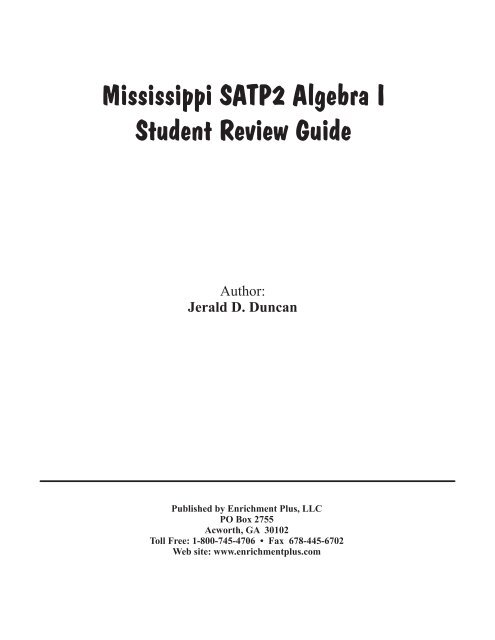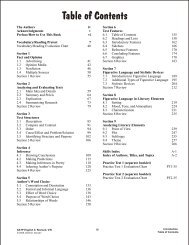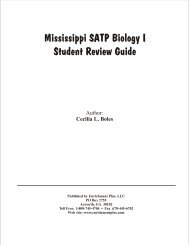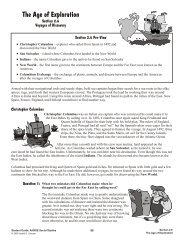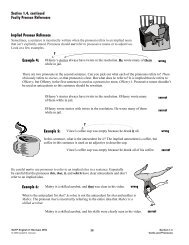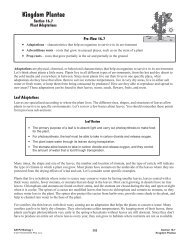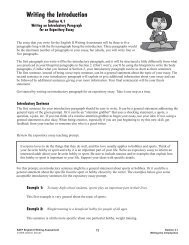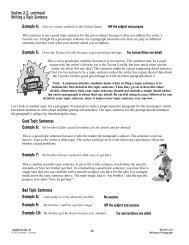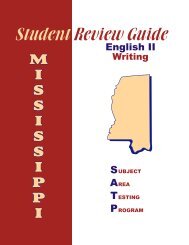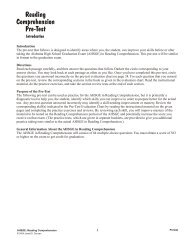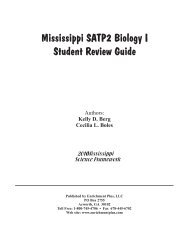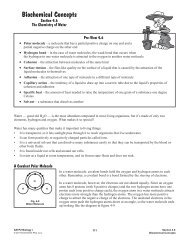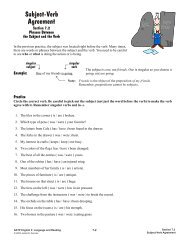Mississippi SATP2 Algebra I Student Review Guide - Enrichment Plus
Mississippi SATP2 Algebra I Student Review Guide - Enrichment Plus
Mississippi SATP2 Algebra I Student Review Guide - Enrichment Plus
You also want an ePaper? Increase the reach of your titles
YUMPU automatically turns print PDFs into web optimized ePapers that Google loves.
<strong>Mississippi</strong> <strong>SATP2</strong> <strong>Algebra</strong> I<br />
<strong>Student</strong> <strong>Review</strong> <strong>Guide</strong><br />
Author:<br />
Jerald D. Duncan<br />
Published by <strong>Enrichment</strong> <strong>Plus</strong>, LLC<br />
PO Box 2755<br />
Acworth, GA 30102<br />
Toll Free: 1-800-745-4706 • Fax 678-445-6702<br />
Web site: www.enrichmentplus.com
<strong>Mississippi</strong> SATP <strong>Algebra</strong> I<br />
<strong>Student</strong> <strong>Review</strong> <strong>Guide</strong><br />
by<br />
Jerald D. Duncan<br />
Kelly D. Berg<br />
Project Coordinator and Executive Editor<br />
<strong>Enrichment</strong> <strong>Plus</strong>, LLC<br />
Publisher<br />
All rights reserved<br />
Copyright 2012 <strong>Enrichment</strong> <strong>Plus</strong>, LLC<br />
The text and graphics of this publication, or any part thereof, may not be reproduced or transmitted in any form or by<br />
any means, electronic or mechanical, including photocopying, recording, storage in an information retrieval system, or<br />
otherwise, without the prior written permission of the copyright holder.<br />
This publication includes some images from CorelDRAW 9 which are protected by the copyright laws of the United<br />
States, Canada, and elsewhere. Used under license. Some images also acquired from © 2008 www.clipart.com.<br />
030409/030409AK
Table of Contents<br />
The Author/Acknowledgments v Section 7<br />
Preface/How to Use This Book vi Using Formulas<br />
7.1 Perimeter and Circumference Formulas 115<br />
Pretest 7 7.2 Area and Surface Area Formulas 118<br />
Evaluation Chart 26 7.3 Volume Formulas 121<br />
7.4 Square Root Applications in Geometry<br />
Section 1 Word Problems 123<br />
<strong>Algebra</strong> Basics 7.5 Using the Pythagorean Theorem 125<br />
1.1 Classifying Numbers 27 7.6 Rearranging Formulas 129<br />
1.2 Math and <strong>Algebra</strong> Vocabulary 31 7.7 Rearranging Variables in Word Problems 131<br />
1.3 Positive and Negative Numbers 34 7.8 Rearranging Formulas to Solve<br />
1.4 Substitution Principle 37 Word Problems 133<br />
Section 1 <strong>Review</strong> 39 Section 7 <strong>Review</strong> 135<br />
Section 2 Section 8<br />
Properties of Real Numbers<br />
Inequalities<br />
2.1 Basic Properties 41 8.1 Solving Simple Inequalities 137<br />
2.2 Introduction to Order of Operations 45 8.2 Solving Multi-Step Inequalities 140<br />
2.3 Order of Operations with Grouping Symbols 47 8.3 Graphing Inequalities 142<br />
Section 2 <strong>Review</strong> 51 8.4 Solving Word Problems with Inequalities 145<br />
8.5 Understanding Averages 149<br />
Section 3 Section 8 <strong>Review</strong> 152<br />
Exponents and Roots<br />
3.1 Multiplying and Dividing with Exponents 53 Section 9<br />
3.2 Powers Raised to Powers 55 Absolute Value<br />
3.3 Negative Exponents 57 9.1 Solving Absolute Value Equations 155<br />
3.4 Roots 59 9.2 Solving Absolute Value from a Number Line 158<br />
3.5 Fractional Exponents 60 9.3 Solving and Graphing Absolute Value<br />
Section 3 <strong>Review</strong> 61 Inequalities 160<br />
9.4 Interpreting Absolute Value Graphs 162<br />
Section 4 9.5 Solving Absolute Value Word Problems 164<br />
The Language of <strong>Algebra</strong> Section 9 <strong>Review</strong> 165<br />
4.1 Key Words in Word Problems 63<br />
4.2 Rate Problems 67 Section 10<br />
4.3 Using Rates in Equations 70 Polynomials<br />
4.4 Setting up More Equations from 10.1 Introducing Polynomials 169<br />
Word Problems 75 10.2 Multiplying Monomials 170<br />
4.5 Reverse Word Problems 78 10.3 Multiplying a Polynomial by a Monomial 172<br />
4.6 Dimensional Analysis 80 10.4 Adding Polynomials 174<br />
Section 4 <strong>Review</strong> 82 10.5 Subtracting Polynomials 176<br />
10.6 Multiplying Binomials 179<br />
Section 5 Section 10 <strong>Review</strong> 183<br />
<strong>Algebra</strong>ic Equations<br />
5.1 Substitution Principle 85 Section 11<br />
5.2 The Addition Principle 87 Rational Expressions<br />
5.3 The Multiplication Principle 89 11.1 Dividing Monomials 185<br />
Section 5 <strong>Review</strong> 94 11.2 Negative Exponents 187<br />
11.3 Rational Expressions to a Power 190<br />
Section 6 Section 11 <strong>Review</strong> 192<br />
Multi-Step Equations<br />
6.1 Introduction to Multi-Step Equations 95 Section 12<br />
6.2 Combining Like Terms 97 Polynomial Applications<br />
6.3 Variables on Both Sides 99 12.1 Perimeter and Circumference Word Problems 195<br />
6.4 Equations with Parentheses 101 12.2 Area Word Problems 198<br />
6.5 Equations with Decimals or Fractions 102 12.3 Area of Combined Shapes 201<br />
6.6 Identifying Mistakes 105 12.4 Surface Area Word Problems 204<br />
6.7 Solving <strong>Algebra</strong> Word Problems 109 12.5 Volume Word Problems 206<br />
Section 6 <strong>Review</strong> 112 Section 12 <strong>Review</strong> 208<br />
<strong>SATP2</strong> <strong>Algebra</strong><br />
© 2012 <strong>Enrichment</strong> <strong>Plus</strong>, LLC<br />
iii<br />
Introduction<br />
Table of Contents
Section 13 Section 20<br />
Factoring Polynomials<br />
Slope<br />
13.1 Simple Factoring 211 20.1 Introducing Slope 303<br />
13.2 Factoring Perfect Squares and 20.2 Calculating Slope from Two Points 307<br />
Difference of Squares 214 20.3 Slope-Intercept Form 309<br />
13.3<br />
2<br />
Factoring Trinomials x + bx + c<br />
217 20.4 Comparing Slope 312<br />
13.4<br />
2<br />
Factoring Trinomials ax + bx + c<br />
220 20.5 Translating Lines 315<br />
13.5 Prime Factors 224 20.6 Finding an Equation Using Point and Slope 317<br />
13.6 Factoring Word Problems 226 20.7 Finding an Equation Using Two Points 318<br />
Section 13 <strong>Review</strong> 229 Section 20 <strong>Review</strong> 321<br />
Section 14 Section 21<br />
Factoring Rational Expressions<br />
Slope as a Rate of Change<br />
14.1 Factoring a Common Monomial 231 21.1 Using Rise Over Run 325<br />
14.2 Factoring a Common Binomial 234 21.2 Introducing Slope as a Rate of Change 327<br />
14.3 Rational Expression Word Problems 236 21.3 Rate of Change in a Table 331<br />
Section 14 <strong>Review</strong> 239 21.4 Using a Data Table to Find the Equation<br />
of a Line 333<br />
Section 15 21.5 Rate of Change on a Graph 336<br />
Quadratic Equations 21.6 Graphing Multiple Rates of Change 339<br />
15.1 Solving Quadratic Equations by Factoring 241 Section 21 <strong>Review</strong> 341<br />
15.2 Solving Quadratic Equations by Completing<br />
the Square 244 Section 22<br />
15.3 Solving Quadratic Equations by Using Problem Solving With Slope<br />
the Quadratic Formula 247 22.1 Recognizing the Graph from Given Data 343<br />
15.4 Using the Quadratic Discriminant 250 22.2 Calculating an Equation from a Graph 345<br />
Section 15 <strong>Review</strong> 253 22.3 Extrapolating by Using a Graph 347<br />
22.4 Using Slope to Find Parallel Lines 350<br />
Section 16 22.5 Using Slope to Find Perpendicular Lines 354<br />
Quadratic Applications 22.6 Using Slope to Find Coincidental Lines 357<br />
16.1 Choosing a Method to Solve Quadratics 255 Section 22 <strong>Review</strong> 358<br />
16.2 Quadratic Word Problems: Geometric Shapes 257<br />
16.3 Quadratic Word Problems: Motion Section 23<br />
Applications 260 Matrices<br />
16.4 Finding the Sum and Product of Quadratic 23.1 Introducing Matrices 361<br />
Roots 263 23.2 Adding Matrices 362<br />
Section 16 <strong>Review</strong> 265 23.3 Subtracting Matrices 365<br />
23.4 Multiplying Matrices by a Scalar 368<br />
Section 17 Section 23 <strong>Review</strong> 372<br />
The Coordinate Plane<br />
17.1 Introducing the Coordinate Plane 267 Section 24<br />
17.2 Plotting Points 268 Systems of Equations and Inequalities<br />
17.3 Distance Formula 269 24.1 Introducing Systems of Equations 375<br />
17.4 Midpoint Formula 272 24.2 Solving Systems of Equations by Substitution 378<br />
17.5 Geometric Shapes on a Coordinate Plane 274 24.3 Solving Systems of Equations by Elimination 380<br />
Section 17 <strong>Review</strong> 276 24.4 Systems of Inequalities in Slope-Intercept<br />
Form 384<br />
Section 18 24.5 Systems of Inequalities in Standard Form 387<br />
Linear Equations and Graphs 24.6 Using Systems of Equations in Word<br />
18.1 Introducing Linear Equations 277 Problems 389<br />
18.2 The Standard Form of a Line 278 Section 24 <strong>Review</strong> 392<br />
18.3 Solving for a Point 284<br />
18.4 Using a Table to Graph a Linear Equation 286 Section 25<br />
18.5 Graphing Horizontal and Vertical Lines 289 Functions<br />
Section 18 <strong>Review</strong> 291 25.1 Introducing Functions 395<br />
25.2 Types of Functions 398<br />
Section 19 25.3 Determining Domain and Range from a<br />
Linear Inequalities and Graphs Table or Equation 401<br />
19.1 Graphing Linear Inequalities 293 25.4 Determining Domain and Range from a<br />
19.2 Reading Inequality Graphs 296 Graph 403<br />
19.3 Linear Inequalities Applications 298 25.5 Linear Functions from Tables 408<br />
Section 19 <strong>Review</strong> 301 Section 25 <strong>Review</strong> 410<br />
<strong>SATP2</strong> <strong>Algebra</strong><br />
© 2010 <strong>Enrichment</strong> <strong>Plus</strong>, LLC<br />
iv<br />
Introduction<br />
Table of Contents
Section 26<br />
Appendix, Scatter Plots with the Calculator<br />
Non-linear Functions (Calculator Instructions) A-1<br />
26.1 Interpreting Graphs and Tables of Quadratic<br />
Functions 413 Index A-5<br />
26.2 Quadratic Equations from Graphs and Tables 417<br />
26.3 Absolute Value Functions 421 Practice Test 1 (separate booklet)<br />
26.4 Change in a Variable 425 Formula Sheet PT1-5<br />
Section 26 <strong>Review</strong> 429 Practice Test 1 Evaluation Chart PT1-23<br />
Section 27<br />
Practice Test 2 (separate booklet)<br />
Scatter Plots Formula Sheet PT2-5<br />
27.1 Introducing Scatter Plots 433 Practice Test 1 Evaluation Chart PT2-22<br />
27.2 Determining Data Trends 435<br />
27.3 Making Predictions with Scatter Plots 440<br />
Section 27 <strong>Review</strong> 443<br />
What is New in this Edition?<br />
This edition has been revised to reflect the changes made to the <strong>Algebra</strong> I framework as given in the 2007 <strong>Mississippi</strong><br />
Mathematics Framework Revised. Some teaching material that dealt specifically with competencies and objectives<br />
that were removed from the new framework has been removed in this edition. Other material has been added for<br />
competencies and objectives that were added to the new framework. The level of difficulty for problems has been<br />
adjusted to reflect the correct depth of knowledge (DOK) as indicated by the new framework.<br />
The Author<br />
Jerald D. Duncan has been involved with education for the past 30 years. He has been a classroom teacher at the<br />
Middle School and High School levels, the assistant to the Vocational Director, Cobb County Schools, the<br />
Apprenticeship Coordinator, Cobb County Schools, and a curriculum materials author.<br />
He is a graduate of Emmanuel College, Franklin Springs, GA and Georgia State University in Atlanta.<br />
Jerald is a nationally recognized Curriculum Development facilitator with curriculum projects completed in Alabama,<br />
Georgia, Michigan, and Pennsylvania. He has also conducted more than 40 teacher training workshops in over a<br />
dozen states in the areas of Applied Mathematics, Academic and Vocational Integration, Cooperative Learning, and<br />
Reading Across the Curriculum. He is also a CORD certified trainer in the areas of Applied Math, CORD <strong>Algebra</strong>,<br />
CORD Geometry, and Principles of Technology. Jerald is a frequent presenter at the SREB summer conferences and<br />
has presented at the Regional NCTM Conference.<br />
Jerald has previously authored resource materials for Applied Math, CORD <strong>Algebra</strong>, CORD Geometry, Applied<br />
Biology/Chemistry, and Principles of Technology, and <strong>Student</strong> <strong>Review</strong> <strong>Guide</strong>: Math, and <strong>Student</strong> <strong>Review</strong> <strong>Guide</strong>:<br />
Social Studies, Alabama High School Graduation Exam.<br />
Acknowledgments<br />
I would like to thank my wife, Susan, and my children, Josh, Will and Matt, for their encouragement, understanding,<br />
and sacrifices while most of my waking moments were devoted to revising this book. I would also like to thank Julie<br />
Sawyer and Laura Silvernale for their editorial work and Kelly Berg who keeps us all straight, somehow. Without the<br />
encouragement from my family and help from friends and colleagues, this book would have never happened.<br />
<strong>SATP2</strong> <strong>Algebra</strong><br />
© 2010 <strong>Enrichment</strong> <strong>Plus</strong>, LLC<br />
v<br />
Introduction<br />
Table of Contents
Preface<br />
The <strong>Mississippi</strong> <strong>SATP2</strong> <strong>Algebra</strong> I <strong>Student</strong> <strong>Review</strong> <strong>Guide</strong> is written to help students review the skills needed to pass<br />
the <strong>Algebra</strong> I end-of-course test in <strong>Mississippi</strong>. This comprehensive guide is based on the 2007 <strong>Mississippi</strong> <strong>Algebra</strong> I<br />
Framework (Revised) Competencies as correlated by the <strong>Mississippi</strong> State Department of Education.<br />
How To Use This Book<br />
<strong>Student</strong>s:<br />
The <strong>Algebra</strong> I end-of-course test is required for graduation. You must pass the state end-of-course test, which contains<br />
65 multiple-choice questions. This book is a review for the <strong>Algebra</strong> I end-of-course test.<br />
jTake the pre-test at the front of this book. The pre-test covers the <strong>Algebra</strong> I skills as they will be tested on the<br />
end-of-course test. The pre-test is designed to identify areas that you need to review.<br />
kScore the pre-test. Using the pre-test evaluation chart, circle the questions that you answered incorrectly.<br />
lFor each question that you missed on the pre-test, review the corresponding sections in the book. Read the<br />
instructional material, do the practice exercises, and take the section review tests at the end of each section.<br />
mAfter reviewing the skills, take the two practice tests (also provided as separate booklets). These practice tests<br />
are written to look similar to the actual <strong>Algebra</strong> I end-of-course test, so they will give you practice in taking the<br />
test.<br />
nAfter taking Practice Test 1 and/or Practice Test 2, use the practice test evaluation charts, which are found<br />
directly after each practice test, to identify areas for further review and practice. The practice test evaluation<br />
charts can be used in the same way as the pre-test evaluation charts.<br />
Teachers:<br />
This review guide is also intended to save you, the teacher, time in the classroom. It can be used for classroom<br />
instruction or for individual student review. Since this student guide offers review for ALL of the <strong>Mississippi</strong><br />
Curriculum Framework for the <strong>Algebra</strong> I course, you, the teacher, have one consolidated resource of materials to help<br />
your students prepare for the end-of-course test.<br />
jWhen teaching or tutoring individual students, use the strategy outlined above for students. By taking the pretest,<br />
students can identify areas that need improvement. The pre-test evaluation chart directs the student to the<br />
sections they need to review for instruction and additional practice.<br />
kFor classroom study, use this guide to supplement lesson plans and to give additional review for skills required<br />
by the <strong>Algebra</strong> I Framework Competencies. Purchase a class set of guides for use in the classroom or assign<br />
guides to students for out-of-classroom work.<br />
lAssign the practice tests (provided in separate booklets) as comprehensive review tests.<br />
mUse the practice test evaluation charts found after each practice test to identify areas needing further review.<br />
nTo establish benchmarks, you may want to use one of the practice tests (provided in separate booklets) as a pretest.<br />
Then, after the students have completed all the exercises in the workbook, use the second practice test to<br />
gauge progress. You should see marked improvement between the initial and final benchmarks. (You may also<br />
want to use the pre-test in this book to get an initial score, but the question distribution for each competency in<br />
the pre-test does not necessarily match the state-specified blueprint.)<br />
oPlease DO NOT photocopy materials from this guide, the pre-test booklet, or the practice test booklets. These<br />
materials are intended to be used as student workbooks, and individual pages should not be duplicated by any<br />
means without permission from the copyright holder. To purchase additional or specialized copies of sections in<br />
this book, please contact the publisher at 1-800-745-4706.<br />
<strong>SATP2</strong> <strong>Algebra</strong><br />
© 2010 <strong>Enrichment</strong> <strong>Plus</strong>, LLC<br />
vi<br />
Introduction<br />
Preface
Competency Correlation Chart (Teacher’s Edition)<br />
The chart below correlates each <strong>Algebra</strong> I Framework Competency as specified by the <strong>Mississippi</strong> State Department<br />
of Education to the student guide. The Text Section column gives the section numbers in the text where each<br />
competency is reviewed. The Pretest and Practice Test columns give the question number(s) in that test that correlates<br />
to each competency.<br />
Framework<br />
Competency<br />
Text<br />
Section(s)<br />
Pre-Test<br />
Practice<br />
Test 1<br />
Practice<br />
Test 2<br />
1a<br />
1.1–1.4, 2.1–2.3, 3.1–3.5, 10.1–10.5, 11.1–11.3<br />
5,7,10,54,62<br />
1,35,43,57,63,64<br />
5,9,15,29,32<br />
1b<br />
23.1–23.4<br />
11,16,48,53<br />
27,41,56<br />
1,22,30<br />
2a<br />
4.1–4.6, 5.1–5.3, 6.1–6.7, 7.6–7.8, 8.1–8.5<br />
1,15,29,31<br />
15,26,52,55<br />
2,11,16,23,41<br />
2b<br />
9.1–9.5<br />
4,9,13<br />
2,9,13<br />
3,14,60,65<br />
2c<br />
25.1–25.4<br />
8,37,42,55<br />
37,48,58,62<br />
8,10,18<br />
2d<br />
21.2, 26.4<br />
19,35<br />
24,45<br />
7,50<br />
2e<br />
4.3, 18.1–18.5, 20.2, 20.3, 20.5–20.7, 21.4, 21.6,<br />
22.1–22.3, 25.5<br />
23,34,39,57<br />
3,11,18,22,60<br />
13,21,51,55<br />
2f<br />
24.2– 24.6<br />
21,26<br />
10,42<br />
17,20<br />
2g<br />
10.1–10.6, 11.1–11.3, 13.6, 14.1–14.3<br />
3,17,64<br />
4,20,25<br />
38,43<br />
2h<br />
13.1–13.4<br />
49,59<br />
6,53<br />
42,52<br />
2i<br />
15.1–15.3, 16.1–16.3, 26.1<br />
25,45,56<br />
23,32,46<br />
4,24,36<br />
2j<br />
13.1–13.5, 15.4<br />
20<br />
17<br />
54<br />
2k<br />
16.4, 26.1–26.3<br />
18,22,33<br />
5,21,33<br />
19,45,57<br />
2l<br />
19.1–19.3<br />
12,41<br />
29<br />
40,47<br />
3a<br />
22.4–22.6, 24.1<br />
24,50,51,65<br />
30,38,39<br />
25,33,35,46,62<br />
3b<br />
20.1, 20.4, 21.1–21.6<br />
14,27,30,46<br />
8,16,28,31,65<br />
12,34,37,53<br />
4a<br />
4.2, 7.1–7.4, 7.6, 7.8<br />
2,28,43<br />
44,61<br />
26,48<br />
4b<br />
7.5, 17.1–17.5, 20.1, 20.2<br />
38,44,47,63<br />
12,47,49<br />
27,44.61<br />
4c<br />
12.1–12.5, 14.3<br />
6,32,60,61<br />
7,19,50<br />
6,28,56<br />
5a<br />
27.1–27.3<br />
40,58<br />
34,40,54<br />
31,39,49,58,<br />
5b<br />
27.2, 27.3<br />
36,52<br />
14,36,51,59<br />
59,63,64<br />
SATP <strong>Algebra</strong> I<br />
© 2006 Jerald D. Duncan<br />
A-9 Appendix<br />
Competency Chart
<strong>Algebra</strong> I<br />
Pre-Test<br />
Introduction<br />
Introduction<br />
The pre-test that follows is designed to identify areas where you can improve your skills before or after taking the<br />
<strong>Algebra</strong> I end-of-course test. This pre-test will be similar in format to the end of course <strong>SATP2</strong> test for <strong>Algebra</strong> I.<br />
Directions<br />
Read the directions on the following page. These directions should be similar to what you will see on the actual<br />
<strong>SATP2</strong> for <strong>Algebra</strong> I. Once you have completed this pre-test, circle the questions you answered incorrectly on the pretest<br />
evaluation chart on page 26. For each question that you missed on the pre-test, review the corresponding sections<br />
in the book as given in the evaluation chart. Read the instructional material, do the practice exercises, and take the<br />
section review tests at the end of each section.<br />
Purpose of the Pre-Test<br />
The following pre-test can be used as practice for the actual <strong>SATP2</strong> <strong>Algebra</strong> I test, but it is primarily a diagnostic tool<br />
to help you identify which skills you can improve in order to prepare better for the actual test. Any pre-test question<br />
answered incorrectly may identify a skill needing improvement or mastery. <strong>Review</strong> the corresponding skill(s)<br />
indicated in the Pre-Test Evaluation Chart by reading the instructional material on the given pages and completing the<br />
practice exercises and reviews. By reviewing each skill, you will improve mastery of the material to be tested on the<br />
<strong>SATP2</strong> <strong>Algebra</strong> I test and potentially increase the score you receive on that test. (The practice tests, which are given in<br />
separate booklets, are provided to give you additional practice taking tests similar to the actual <strong>SATP2</strong> <strong>Algebra</strong> I test.)<br />
Scoring on the Actual <strong>SATP2</strong> for <strong>Algebra</strong> I<br />
The actual test that you will take to pass the <strong>Algebra</strong> I course will consist of 65 multiple-choice questions. Out of these<br />
65 multiple-choice questions, only 53 questions will be scored. The scorable questions are pre-determined. The other<br />
12 multiple-choice questions embedded throughout the test are field-test questions that will not be scored. You will<br />
not know which questions will be scored and which ones will not, so you should answer each and every question as if<br />
it will be scored.<br />
<strong>SATP2</strong> <strong>Algebra</strong> 7<br />
© 2010 <strong>Enrichment</strong> <strong>Plus</strong>, LLC<br />
Pre-Test
58. A growing publishing company plots the<br />
number of books sold each year for its<br />
first 8 years in business. The data is shown<br />
on the scatter plot below.<br />
books<br />
sold<br />
y<br />
100,000<br />
90,000<br />
80,000<br />
70,000<br />
60,000<br />
50,000<br />
40,000<br />
30,000<br />
20,000<br />
10,000<br />
Sales per Year<br />
1 2 3 4 5 6 7 8 9 10<br />
years<br />
Based on the trend shown in the line-of-best<br />
fit, which is the closest to the expected number<br />
of books sold in the tenth year?<br />
x<br />
60. The figure below is made up of two rectangles.<br />
(x + 5) ft<br />
(x + 3) ft<br />
4x ft<br />
(5x + 3) ft<br />
(x + 2) ft<br />
What is the total area, in square feet, of the<br />
figure?<br />
A 12x + 16<br />
2<br />
B 5x + 23<br />
2<br />
C 5x + 8x + 15<br />
2<br />
D 5x + 16x + 15<br />
A B C D<br />
A 75,000<br />
B 82,000<br />
C 94,000<br />
D 97,000<br />
A B C D<br />
59. Which of the following is a factor of<br />
2<br />
6x + 7x – 5?<br />
2<br />
61. If the area of a square is x – 6x + 9, then what<br />
is the length of one of the sides in terms of x?<br />
A<br />
B<br />
C (<br />
D<br />
(2x – 1)<br />
(2x + 1)<br />
3x – 5)<br />
(6x + 1)<br />
A<br />
B<br />
C<br />
D<br />
x + 3<br />
x – 3<br />
x – 6<br />
x – 9<br />
A B C D<br />
A B C D<br />
<strong>SATP2</strong> <strong>Algebra</strong><br />
© 2010 <strong>Enrichment</strong> <strong>Plus</strong>, LLC<br />
24<br />
Pre-Test
62. Which of the following is equivalent to the<br />
expression shown below?<br />
–1 3<br />
2<br />
16a b c<br />
–3 –1<br />
24a b c<br />
5<br />
64. Which of the following is equivalent to the<br />
expression below?<br />
2 2<br />
3x y – xy + 2xy<br />
xy<br />
A<br />
B<br />
2 4<br />
2a b<br />
3<br />
3c<br />
4<br />
2b<br />
4 3<br />
3a c<br />
A<br />
B<br />
C<br />
D<br />
3x + 2y<br />
3 2 2 2 2 3<br />
3x y – x y + 2x y<br />
5<br />
3x – 1 + 2y<br />
C<br />
D<br />
2<br />
2a<br />
2 3<br />
3b c<br />
4 4<br />
2a b<br />
7<br />
3c<br />
A B C D<br />
A B C D<br />
5<br />
63. Line segment UV has a midpoint of 2 , 8<br />
on a coordinate plane. If point U is located at<br />
(1, 5), then which ordered pair represents the<br />
location of point V?<br />
A<br />
(2, 11)<br />
( )<br />
65. Which of these pairs of linear equations<br />
represent two lines that are perpendicular?<br />
2<br />
5<br />
A y = 5 x + 4 and y = 2 x – 2<br />
1<br />
1<br />
B y = – x + 2 and y = 3 x + 2<br />
3<br />
B<br />
C<br />
D<br />
(4, 11)<br />
(4, –1)<br />
3<br />
( 2 , 11)<br />
2<br />
3<br />
C y = x – 4 and y = – x + 3<br />
3<br />
2<br />
D y = 3x + 1 and y = 3x + 4<br />
A B C D<br />
A B C D<br />
<strong>SATP2</strong> <strong>Algebra</strong><br />
© 2010 <strong>Enrichment</strong> <strong>Plus</strong>, LLC<br />
25<br />
Pre-Test
Exponents and Roots<br />
Section 3.3<br />
Negative Exponents<br />
One way to think of negative exponents is to rewrite the<br />
power as a rational number (fraction) with one as the<br />
numerator and the power as the denominator. Or you could<br />
say that positive exponents go in the numerator and<br />
negative exponents move to the denominator and change<br />
their sign to positive. (A negative exponent in the<br />
denominator would move to the numerator.)<br />
Rule for Negative Exponents<br />
–m<br />
a = 1 m<br />
a<br />
Example 1:<br />
–3<br />
Simplify the expression (3) .<br />
Using the rule for negative exponents, the power is moved to the<br />
denominator. Then, the exponent can be simplified.<br />
If you have a multiplication problem to simplify, move factors with negative exponents into the denominator and keep<br />
factors with positive exponents in the numerator. Then you can simplify. Example 2 below shows how.<br />
–3<br />
3<br />
1<br />
3<br />
3<br />
=<br />
1<br />
27<br />
Example 2:<br />
–2 2<br />
Simplify the expression 3 • 6 .<br />
2<br />
Keep the 6 in the numerator since it has a positive<br />
–2<br />
exponent, but move the 3 to the denominator and<br />
change the negative exponent to a positive one. Then do<br />
the math.<br />
2 –2<br />
6 • 3<br />
2 6<br />
6 • 1 = 36 2 2<br />
3 = 3 9<br />
1<br />
shortcut<br />
Now let’s look at a couple of division problems. When a division problem is written with a “÷” sign, you can rewrite it<br />
as a fraction in two different ways. Choose the way that makes the most sense to you.<br />
2<br />
4<br />
= 4<br />
Example 3:<br />
–4 –3<br />
Simplify the expression a ÷ a .<br />
Step 1:<br />
Step 2:<br />
Step 3:<br />
First, write each factor in fraction form.<br />
Remember, dividing by a fraction is the same as<br />
multiplying by its inverse.<br />
Simplify by using the rules of exponents.<br />
–4 –3<br />
a ÷ a<br />
1<br />
4<br />
a • 3<br />
a<br />
1<br />
1<br />
4<br />
a<br />
3<br />
a<br />
= 4 =<br />
a<br />
÷ 1 3<br />
a<br />
1<br />
a<br />
Example 4:<br />
–3 –5<br />
Simplify the expression 2a ÷ 3a .<br />
Step 1:<br />
The “÷” sign can be replaced with a fraction bar. Rewrite as a<br />
fraction before changing the negative exponents. You may see<br />
problems written as fractions this way instead of with a “÷” sign.<br />
–3 –5<br />
2a ÷ 3a<br />
2a<br />
3a<br />
–3<br />
–5<br />
Step 2:<br />
For any variable that has a negative exponent, move it to the other<br />
side of the fraction bar and change the exponent to a positive. Be<br />
careful: only move the variables and not the coefficients!<br />
–3<br />
2 a<br />
–5<br />
3 a<br />
5<br />
2a<br />
3<br />
3a<br />
Step 3:<br />
Now simplify using the rules of exponents.<br />
2<br />
2a<br />
3<br />
or<br />
2<br />
3<br />
2<br />
a<br />
<strong>SATP2</strong> <strong>Algebra</strong> 57<br />
Section 3.3<br />
© 2010 <strong>Enrichment</strong> <strong>Plus</strong>, LLC<br />
Exponents and Roots
Inequalities<br />
Section 8.5<br />
Understanding Averages<br />
Working with averages is another real-world situation that may require the use of<br />
inequalities. When it comes to averages, the one that students are most aware of is the<br />
grades they get for school work. Sounds like a good place to begin.<br />
Average<br />
sum of item<br />
number of items<br />
You can figure out your grade point average by adding all your test scores and then<br />
dividing by the total number of tests. You use this same process to find any average. An<br />
average is the sum of items divided by the number of items.<br />
Let’s start with finding a current average. Suppose you have taken five<br />
tests this semester. Your scores are 88, 75, 91, 77, and 80.<br />
{ 88 , 75, 91, 77, 80 }<br />
Calculate your current average by totaling the current grades and dividing<br />
by five. Round to the nearest whole number. With these grades, your<br />
average is 82.<br />
88 + 75 + 91 + 77 + 80<br />
5<br />
= 82<br />
Example 1:<br />
You have an A average. Your grades are 90, 95, 92, 97, and 93. There is a test scheduled on Friday<br />
before spring break. If you miss the test, you cannot make it up. How much damage can one zero<br />
do to your average if your family decides to leave early for spring break?<br />
Step 1: Calculate the current average.<br />
Step 2: Add one zero and recalculate the average.<br />
Step 3: How much difference did the zero make? Original<br />
average minus the new average is fifteen.<br />
90 + 95 + 92 + 97 + 93<br />
5<br />
90 + 95 + 92 + 97 + 93 + 0<br />
6<br />
93 – 78 = 15<br />
= 93<br />
= 78<br />
One zero made a 15 point difference. You have gone from an A to a C! If<br />
there had been fewer grades, the difference would have been even more drastic.<br />
Now let’s say you have a test coming up and you want to know what grade you need to maintain your average. Since<br />
you probably don’t mind if your average goes up, your calculation becomes an inequality. You want to know the<br />
minimum grade, but any grade higher than that will also work!<br />
Example 2:<br />
Your first five test grades are 88, 75, 91, 77, and 80. What grade do you need to make on the sixth<br />
test to maintain your average?<br />
Step 1:<br />
First, calculate your current average by totaling the<br />
current grades, and then divide by five. From<br />
above, you’ve already seen that these grades<br />
average to 82.<br />
88 + 75 + 91 + 77 + 80<br />
5<br />
= 82<br />
Step 2: To calculate your average after test six, you would<br />
add a variable, T, to stand for the test you haven’t<br />
taken yet and divide by six.<br />
88 + 75 + 91 + 77 + 80 + T<br />
6<br />
<strong>SATP2</strong> <strong>Algebra</strong> 149<br />
© 2010 <strong>Enrichment</strong> <strong>Plus</strong>, LLC<br />
Section 8.5<br />
Inequalities
Rational Expressions<br />
Section 11.2<br />
Negative Exponents<br />
So far all the division of monomials you have seen has been with positive exponents.<br />
What happens when the rational expression has negative exponents? You pray. Just<br />
kidding. Negative exponents aren’t really that bad. You just have to pay attention —<br />
very careful attention. Let’s start with a short review of what you already know about<br />
negative exponents.<br />
Rules for Negative Exponents<br />
–7<br />
y<br />
–3 2<br />
x y<br />
2<br />
y<br />
2<br />
x<br />
3 –2<br />
x y<br />
–2 –2<br />
2x y<br />
–3 –4<br />
3x y<br />
1<br />
7<br />
y<br />
2<br />
y<br />
3 2<br />
x y<br />
2 2<br />
x y<br />
3<br />
x<br />
3 4<br />
2x y<br />
2 2<br />
3x y<br />
You’ve already seen that you can make a negative exponent positive by making it the<br />
denominator of a fraction. But what if you already have a rational expression and the<br />
negative exponents are in the numerator or denominator? You move them. Here’s how.<br />
If the negative exponent is in the numerator, you move it to the denominator. If the<br />
negative exponent is in the denominator, move it to the numerator. It’s just that simple.<br />
When you move negative exponents, they become positive.<br />
If you have all negative exponents in the numerator and the denominator, the variables<br />
swap places. Make sure you don’t swap the coefficients; they already have a positive<br />
exponent. They’re raised to the power of +1.<br />
Negative Exponents in Rational Expressions<br />
If a rational expression has negative exponents, use the rules above to make them positive. Once you make the<br />
exponents positive, you can simplify the rational expression by canceling common factors. Take a look at these<br />
examples.<br />
Example 1: Simplify the expression 2 2 3 .<br />
–3<br />
4 –2<br />
16x y z<br />
12x y z<br />
Since there are negative exponents in the numerator, you move them to the<br />
denominator. Once all the exponents are positive, you can add the exponents<br />
that have the same base.<br />
–3 4 –2<br />
16x y z<br />
2 2 3<br />
12x y z<br />
Step 1: Move the negative exponents to the denominator and<br />
make them positive. Remember to move both the base<br />
and the exponent. Don’t move just the exponent.<br />
Step 2: Add the exponents with the same bases.<br />
Step 3: Factor the coefficients if you can.<br />
Step 4: Cancel the common factors in the coefficients and use<br />
the shortcut to cancel exponents.<br />
Step 5: After cancelling, regroup what’s left.<br />
4<br />
16y<br />
2+3 2 3+2<br />
12x y z<br />
4<br />
16y<br />
2 3 2 3 2<br />
12x x y z z<br />
2<br />
y<br />
4<br />
4 • 4y<br />
5 2 5<br />
4 • 3x y z<br />
2<br />
4y<br />
5 5<br />
3x z<br />
4<br />
16y<br />
5 2 5<br />
12x y z<br />
<strong>SATP2</strong> <strong>Algebra</strong> 187<br />
© 2010 <strong>Enrichment</strong> <strong>Plus</strong>, LLC<br />
Section 11.2<br />
Rational Expressions
Quadratic Applications<br />
Section 16.3<br />
Quadratic Word Problems:<br />
Motion Applications<br />
d = 0.5gt 2<br />
The very mention of the word physics is enough to strike fear in the heart of the<br />
average high school student. It’s not because the concepts are all that hard — it’s<br />
because the math is so scugly! That’s scary and ugly all rolled into one. The good news<br />
is that many of the formulas used to solve physics applications are quadratics. And you know how to solve quadratics,<br />
right? Well, by now you should.<br />
This won’t be a physics lesson, but there are a few scugly application problems that you should see. Have courage!<br />
You can do the math. And you won’t even have to come up with the equation; we’ll give you that. All you have to do<br />
is decide how to solve it and find the right answer.<br />
According to some, Sir Isaac Newton, noted mathematician, was sitting under an apple tree when an apple fell.<br />
Because of Newton’s contributions to the field of science, you now know that the force that caused the apple to fall is<br />
called gravity. The speed of the apple is caused by the acceleration due to gravity.<br />
Example 1: Let’s say Newton saw an apple begin to fall from the top of a tree 11 meters above his head. How<br />
long did he have to move out of the way before the apple would have hit him in the head? Use the<br />
formula below.<br />
2<br />
d = 0.5gt<br />
d = 11 meters (distance the apple fell)<br />
2<br />
g = 9.8 m/s (acceleration due to gravity)<br />
t = time in seconds for the apple to fall<br />
Step 1:<br />
Substitute the values you know into the formula including<br />
the units.<br />
2<br />
Step 2: Do the math. Multiply the 0.5 and the 9.8 m/s .<br />
Step 3:<br />
Step 4:<br />
2 2<br />
Divide by sides by 4.9 m/s . The “m/s ” is a rate, so treat<br />
the units like a fraction. Remember that when you divide<br />
by a fraction, you reverse the numerator and denominator.<br />
The meters cancel. Round to the nearest hundredth.<br />
Now you can take the square root of both sides to solve<br />
2<br />
for t. Notice that when you take the square root of s , you<br />
get just seconds. It takes the apple about 1.5 seconds to<br />
fall 11 meters, so Newton has only 1.5 seconds to get out<br />
of the way!<br />
d = 0.5gt 2<br />
11 m = 0.5 (9.8 m/s<br />
2) t<br />
2<br />
11 m = (4.9 m/s<br />
2)<br />
t<br />
2<br />
11 m<br />
4.9<br />
s 2<br />
•<br />
m<br />
= t<br />
2<br />
2 2<br />
2.24 s = t<br />
1.5 s = t<br />
Example 1 is a fairly easy one. The motion is in only one direction. But if you start throwing things up in the air, they<br />
come back down at the same rate as the apple. Now, you have two directions: first up with the speed you threw it and<br />
then down with the speed due to gravity. When something goes up and then comes back down, its movement is called<br />
projectile motion.<br />
Let’s say you threw a rock straight up into the air at 8 m/s from a height of 1.5 meter.<br />
How long, in seconds, will it take before the rock hits the ground, or h = 0? Without<br />
getting too technical, the 8 and the 1.5 go into the projectile motion equation as shown<br />
on the right. If you set h = 0, that’s all you need to know to solve a problem like this one.<br />
2<br />
h = –4.9t + 8t + 1.5<br />
2<br />
0 = –4.9t + 8t + 1.5<br />
<strong>SATP2</strong> <strong>Algebra</strong> 260<br />
© 2010 <strong>Enrichment</strong> <strong>Plus</strong>, LLC<br />
Section 16.3<br />
Quadratic Applications
Non-linear Functions<br />
Section 26.2<br />
Quadratic Equations From<br />
Graph and Tables<br />
Now that you know how to find the information about quadratic functions from a<br />
graph or a table, let’s see what you can do with it.<br />
Let’s say you have a graph or a table and need to match it to its equation. To match a graph<br />
or table to a quadratic equation, you need to check at least three points. You could take each<br />
set of integer coordinates from the graph or table, substitute them for x and y values in the quadratic equation, and<br />
then simplify. If the two sides are equal for each set of points, the graph or table matches the equation. The easiest<br />
points to pick, if they are integers, are the two x-intercepts and the y-intercept, but any three points will do.<br />
Substituting three different points into an equation to see if the equation is true<br />
can be time consuming. It would really be helpful to get an equation from<br />
looking at a graph or a table. You can do just that if you memorize the vertex<br />
form of a quadratic equation as given on the right. It’s called the “vertex” form<br />
because it uses the values for the vertex, h and k. As long as you can identify the<br />
vertex from a graph or a table and have one additional point, you can use this<br />
formula to find the equation of the quadratic.<br />
“Vertex” Formula for a<br />
Quadratic Equation<br />
2<br />
y = a(x – h) + k<br />
Quadratic Equations From Graphs<br />
Let’s start with a graph. Find the equation for the quadratic function graphed below.<br />
–8 –6 –4 –2<br />
–2<br />
–4<br />
–6<br />
–8<br />
8<br />
6<br />
4<br />
2<br />
0 2 4 6 8<br />
This is a three step process:<br />
First, you will need to find the coordinates of the vertex and one other<br />
coordinate from the graph. The y-intercept is a good one to use. Label the x-<br />
coordinate of the vertex as h and the y-coordinate k — you’ll see why in a<br />
minute. Also, label the coordinates of the other point as x and y.<br />
h k x y<br />
vertex = (–1, –4) y-intecept = (0, –3)<br />
Next, you’ll need the “vertex” form of a quadratic equation. It may look weird, but it’s<br />
the quadratic function written in terms of the x and y values of the vertex (h, k).<br />
Substitute the values you labeled into the equation and solve for a. Now, you know<br />
2<br />
two things about your equation: the coefficient of the x term is 1 and the constant term<br />
is –3. How do you get the rest of the quadratic? Glad you asked.<br />
2<br />
y = a(x – h) + k<br />
2<br />
–3 = a(0 – (–1)) + (–4)<br />
2<br />
–3 = a(1) – 4<br />
–3 = a – 4<br />
1 = a<br />
2<br />
y = a (x – h) + k<br />
y = 1(x – (–1))<br />
2 – 4<br />
y = (x + 1)<br />
2 – 4<br />
y = (x + 1)(x + 1) – 4<br />
2<br />
y = x + 2x + 1 – 4<br />
Finally, take the “vertex” form of the equation and substitute the values of a, h,<br />
and k. Simplify and you have the quadratic function that matches the graph.<br />
That wasn’t so bad, was it? It would be well worth your time to memorize this<br />
“vertex” formula. You’ll find it very useful if you need to match a graph to a<br />
quadratic equation.<br />
2<br />
y = x + 2 x – 3<br />
<strong>SATP2</strong> <strong>Algebra</strong> 417<br />
Section 26.2<br />
© 2010 <strong>Enrichment</strong> <strong>Plus</strong>, LLC<br />
Non-linear Functions
Scatter Plots<br />
Section 27.2<br />
Determining Data Trends<br />
When scatter plots have a definite trend, you can actually draw a line that “fits” the<br />
data. If you eyeball the relationship, it’s called a trend line. If you do a statistical<br />
analysis (which is what your calculator does), it’s called a line-of-best fit. A trend line<br />
is just a guess based on observation. The line-of-best fit is a calculation based on<br />
statistical analysis. Both are still best guesses, but the line-of-best fit is a better guess<br />
Trend Lines<br />
y<br />
27<br />
24<br />
21<br />
18<br />
15<br />
12<br />
9<br />
6<br />
3<br />
x<br />
0 2 4 6 8 10 12<br />
Finding a trend line by hand is tricky business. But there are a few<br />
guidelines you can use to make the attempt a little easier.<br />
You’ll need a straight edge — something that won’t cover up the<br />
data like a string or a stick of spaghetti (uncooked of course; you<br />
need a straight line — not a curve).<br />
Try to place the spaghetti, or whatever you’re using, on the graph<br />
so that there are the same number of points above the line as<br />
below the line. Resist the temptation to place the line through<br />
both the first and last points. That’s usually not a good fit.<br />
It’s okay to have points on the line, and you don’t count those<br />
when you average points above and below the line.<br />
Move the line so that as many points as possible are as close as you can get them to the line. It may take a bit of trial<br />
and error to make that happen. When you have it, mark the beginning and end of your spaghetti line and draw the<br />
pencil line between the two points.<br />
That’s your trend line. Check it out to see how well you did. When you count the points above and below the line, you<br />
get seven above and seven below. So far, so good. It also looks like you have the distance of the dots above and below<br />
the line about equal — some are close and some are not, but all-in-all, they are about the same. That’s a good trend<br />
line, but it’s not the only trend line.<br />
Let’s say you laid out your spaghetti to look like line A on the graph below. Isn’t this a trend line, too? Sure it is. But<br />
is it the best one? Count the dots above and below the line. Four above and ten below is not very close to equal, is it?<br />
Look at the dots. The spacing of the dots above and below the line<br />
aren’t too even either. The dots above the line are a lot closer to<br />
the line than the dots below it. So even though it is a trend line, it’s<br />
probably not the best trend for the data.<br />
Line B has the same problem. It’s a trend line, but it’s just not the<br />
best one given the description above.<br />
If you are given choices of which trend line is best, choose<br />
according to the following guidelines:<br />
Good Trend Lines<br />
Same number of points above and below the line<br />
Points as close to the line as possible<br />
Equal average distances for points above and below the line<br />
y<br />
27<br />
24<br />
21<br />
18<br />
15<br />
12<br />
9<br />
Line A<br />
6<br />
Line B<br />
3<br />
x<br />
0 2 4 6 8 10 12<br />
<strong>SATP2</strong> <strong>Algebra</strong> 435<br />
Section 27.2<br />
© 2010 <strong>Enrichment</strong> <strong>Plus</strong>, LLC<br />
Scatter Plots
<strong>Mississippi</strong> SATP <strong>Algebra</strong> I<br />
Revised<br />
<strong>Student</strong> <strong>Review</strong> <strong>Guide</strong>:<br />
Practice Test<br />
1<strong>Mississippi</strong><br />
2007 Mathematics Framework<br />
Revised<br />
Published and Distributed by <strong>Enrichment</strong> <strong>Plus</strong>, LLC<br />
PO Box 2755<br />
Acworth, GA 30102<br />
Toll Free: 1-800-745-4706 • Fax 678-445-6702<br />
Email: eplus@birch.net<br />
Web site: www.enrichmentplus.com
23. What is the solution set to the equation below?<br />
2<br />
A {– , 1}<br />
3<br />
2<br />
B {– , –1}<br />
3<br />
C {2, 3}<br />
D {–3, 2}<br />
2<br />
3x – x = 2<br />
26. For routine plumbing services, Flush-Rite<br />
Plumbing charges its customers a flat rate of<br />
$75 plus a labor charge of $130 per hour. If the<br />
company bills a customer for $400, how many<br />
hours of labor were billed?<br />
A<br />
B<br />
C<br />
D<br />
2 hours<br />
2.5 hours<br />
3.25 hours<br />
5 hours<br />
A B C D A B C D<br />
x y<br />
24. If + = 2, which statement best explains<br />
4 3<br />
how the value of y changes each time x is<br />
increased by 1 unit?<br />
A<br />
B<br />
C<br />
D<br />
The value of y increases<br />
The value of y decreases<br />
The value of y increases<br />
The value of y decreases<br />
3<br />
4<br />
3<br />
4<br />
4<br />
3<br />
4<br />
3<br />
units.<br />
units.<br />
units.<br />
units.<br />
A B C D<br />
27. Matrix Y is the result when matrix X is<br />
multiplied by a scalar.<br />
a –18<br />
X =<br />
48 –24<br />
Y =<br />
–8 36<br />
] [ –6 27<br />
[ ]<br />
What is the value of a in matrix Y?<br />
A –36<br />
B –64<br />
C 36<br />
D 64<br />
A B C D<br />
25. Which of the following is equivalent to the<br />
algebraic expression below?<br />
2 2<br />
3(2x y – 3x + 4) – 4(3x y – 2x – 3)<br />
28. Which of the following linear equations when<br />
graphed on the same coordinate grid is closest<br />
to horizontal?<br />
A<br />
y = 2x<br />
A –<br />
B<br />
C<br />
2<br />
6x y – x<br />
2<br />
18x y – 17x<br />
2<br />
6x y – 17x + 24<br />
2<br />
D – 6x y – x + 24<br />
B<br />
C<br />
2<br />
y = x – 1<br />
3<br />
y = x + 1<br />
A B C D<br />
D<br />
1<br />
y = x + 5<br />
2<br />
A B C D<br />
<strong>SATP2</strong> <strong>Algebra</strong> I<br />
© 2010 <strong>Enrichment</strong> <strong>Plus</strong>, LLC<br />
PT1-11<br />
Practice Test 1
59. A school counselor picked 10 students at random and took a survey to find the average hours of television<br />
watched each day after school. She compared each answer to the student’s grade point average and<br />
plotted the results below.<br />
4<br />
GPA Comparison<br />
Grade Point Average<br />
3<br />
2<br />
1<br />
0 2 4 6 8<br />
Hours of Television<br />
Which line below represents the best trend line for the data?<br />
A<br />
GPA Comparison<br />
C<br />
GPA Comparison<br />
4<br />
4<br />
Grade Point Average<br />
3<br />
2<br />
1<br />
Grade Point Average<br />
3<br />
2<br />
1<br />
0 2 4 6 8<br />
Hours of Television<br />
0 2 4 6 8<br />
Hours of Television<br />
B<br />
4<br />
GPA Comparison<br />
D<br />
4<br />
GPA Comparison<br />
Grade Point Average<br />
3<br />
2<br />
1<br />
Grade Point Average<br />
3<br />
2<br />
1<br />
0 2 4 6 8<br />
Hours of Television<br />
0 2 4 6 8<br />
Hours of Television<br />
A B C D<br />
<strong>SATP2</strong> <strong>Algebra</strong> I<br />
© 2010 <strong>Enrichment</strong> <strong>Plus</strong>, LLC<br />
PT1-20<br />
Practice Test 1
<strong>Algebra</strong> I<br />
Practice Test 1<br />
Evaluation Chart<br />
If you missed<br />
question #:<br />
1<br />
2<br />
3<br />
4<br />
5<br />
6<br />
7<br />
8<br />
9<br />
10<br />
11<br />
12<br />
13<br />
14<br />
15<br />
16<br />
17<br />
18<br />
19<br />
20<br />
21<br />
22<br />
23<br />
24<br />
25<br />
26<br />
27<br />
28<br />
29<br />
30<br />
31<br />
32<br />
33<br />
34<br />
35<br />
Go to<br />
section(s):<br />
1.2, 3.1, 3.3, 11.1, 11.2<br />
4.1, 4.2, 4.3, 8.4<br />
17.1, 20.1, 20.2, 20.3, 20.6, 20.7<br />
13.1, 14.1<br />
13.4, 15.1, 16.4<br />
1.1, 13.1, 13.5, 15.4<br />
7.2, 10.4, 10.6, 12.2<br />
20.1, 20.3, 20.4<br />
5.2, 5.3, 6.1, 6.2, 9.1<br />
18.2, 19.1, 19.2, 20.3, 24.1, 24.4, 24.5<br />
20.1, 20.2, 20.3, 20.6, 20.7, 21.3, 21.4<br />
4.1, 7.5<br />
9.1, 9.3<br />
27.2<br />
8.1, 8.2, 8.3<br />
21.2<br />
1.1, 13.4, 13.5<br />
20.1, 20.2, 20.3, 20.6, 20.7<br />
13.2, 13.6<br />
10.1, 10.4<br />
26.1, 26.2<br />
20.1, 20.6<br />
13.4, 15.1<br />
21.2<br />
2.1, 10.1, 10.2, 10.3, 10.4, 10.5<br />
4.1, 4.2, 4.3, 6.7<br />
23.1, 23.4<br />
20.1, 20.3, 20.4<br />
19.1, 19.2<br />
22.4, 22.5, 22.6, 24.1<br />
21.2, 21.6<br />
26.1<br />
26.3<br />
27.3<br />
2.1, 10.1, 10.3, 10.4, 10.5<br />
If you missed<br />
question #:<br />
36<br />
37<br />
38<br />
39<br />
40<br />
41<br />
42<br />
43<br />
44<br />
45<br />
46<br />
47<br />
48<br />
49<br />
50<br />
51<br />
52<br />
53<br />
54<br />
55<br />
56<br />
57<br />
58<br />
59<br />
60<br />
61<br />
62<br />
63<br />
64<br />
65<br />
Go to<br />
section(s):<br />
27.2<br />
25.3<br />
20.3, 22.4<br />
20.1, 20.3, 22.5<br />
27.2<br />
23.1, 23.2<br />
4.1, 24.2, 24.3, 24.6<br />
2.1, 10.1, 10.3, 10.4, 10.5<br />
7.2<br />
7.2, 10.6, 26.4<br />
15.2<br />
17.1, 17.2, 17.5<br />
25.1<br />
17.1, 17.4, 17.5<br />
10.4, 12.1<br />
27.2<br />
8.4, 8.5<br />
13.4<br />
27.1<br />
8.1, 8.2<br />
23.1, 23.3<br />
1.4<br />
25.1, 25.4<br />
27.2<br />
21.2, 21.6<br />
7.1, 7.5<br />
10.1, 13.4, 14.2, 14.3<br />
2.1<br />
1.3, 1.4, 2.1, 2.2, 2.3<br />
21.2, 21.5, 22.1, 22.2<br />
<strong>SATP2</strong> <strong>Algebra</strong> I<br />
© 2010 <strong>Enrichment</strong> <strong>Plus</strong>, LLC<br />
PT1-23<br />
Practice Test 1


